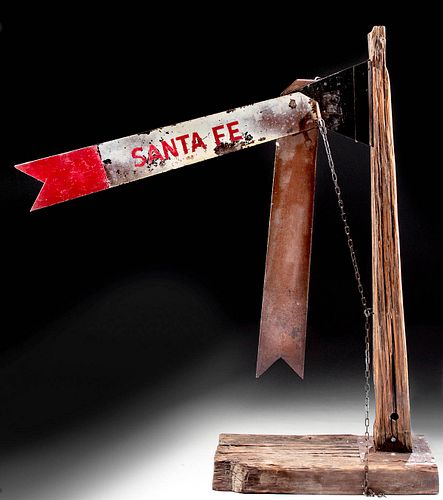19th C. American Wood & Iron Lower Quadrant Semaphore
Lot 167
About Seller
Artemis Fine Arts
686 S Taylor Ave, Ste 106
Louisville, CO 80027
United States
Selling antiquities, ancient and ethnographic art online since 1993, Artemis Gallery specializes in Classical Antiquities (Egyptian, Greek, Roman, Near Eastern), Asian, Pre-Columbian, African / Tribal / Oceanographic art. Our extensive inventory includes pottery, stone, metal, wood, glass and textil...Read more
Categories
Estimate:
$1,200 - $1,800
Absentee vs Live bid
Two ways to bid:
- Leave a max absentee bid and the platform will bid on your behalf up to your maximum bid during the live auction.
- Bid live during the auction and your bids will be submitted real-time to the auctioneer.
Bid Increments
| Price | Bid Increment |
|---|---|
| $0 | $25 |
| $300 | $50 |
| $1,000 | $100 |
| $2,000 | $250 |
| $5,000 | $500 |
| $10,000 | $1,000 |
| $20,000 | $2,500 |
| $50,000 | $5,000 |
| $100,000 | $10,000 |
| $200,000 | $20,000 |
About Auction
By Artemis Fine Arts
Jul 1, 2020
Set Reminder
2020-07-01 10:00:00
2020-07-01 10:00:00
America/New_York
Bidsquare
Bidsquare : Ancient | Near-Eastern | Asian Art
https://www.bidsquare.com/auctions/artemis-gallery/ancient-near-eastern-asian-art-5276
Ancient art from Egypt, Greece, Italy and the Near East, as well as Asian, Fossils, Pre-Columbian, Native American, African / Tribal / Oceanic, Spanish Colonial, Russian Icons, Fine art, much more! Artemis Fine Arts info@artemisfinearts.com
Ancient art from Egypt, Greece, Italy and the Near East, as well as Asian, Fossils, Pre-Columbian, Native American, African / Tribal / Oceanic, Spanish Colonial, Russian Icons, Fine art, much more! Artemis Fine Arts info@artemisfinearts.com
- Lot Description
North America, United States, probably New Mexico, ca. mid to late 19th century CE. A fine train signal known as a lower quadrant semaphore of a dwarf size compared to the taller, full-sized versions. Patented in the 1840s by Joseph James Stevens, lower quadrant semaphores were used by articulating its fishtail-notched iron blades to indicate the safety of the proceeding stretch of track, with horizontal meaning to stop, and vertical or lowered meaning 'open' or 'all safe.' The white and red blades were easy for train conductors to spot in the distance, and red lettering reading 'Santa Fe' indicates this was used on the main line of the Burlington Northern Santa Fe (or BNSF) railway network. Size (base): 21.125" L x 11.75" W x 44" H (53.7 cm x 29.8 cm x 111.8 cm); (flags): 29.125" L (74 cm)
Provenance: private Glorieta, New Mexico, USA collection, acquired in January 2019; ex-Jim Williams collection, Missouri, USA, acquired in 2018 from a private Tulsa, Oklahoma, USA collection
All items legal to buy/sell under U.S. Statute covering cultural patrimony Code 2600, CHAPTER 14, and are guaranteed to be as described or your money back.
A Certificate of Authenticity will accompany all winning bids.
We ship worldwide and handle all shipping in-house for your convenience.
#155424Small areas of loss to platform and vertical bar as shown. Minor overpainting to red lettering on one blade, with desiccation and several stable fissures to wood commensurate with age, and very slight bending to overall forms of blades. Great patina throughout. Blades still articulate.Condition
- Shipping Info
-
All shipping is handled in-house for your convenience. Your invoice from Artemis Gallery will include shipping calculation instructions. If in doubt, please inquire BEFORE bidding for estimated shipping costs for individual items.
-
- Buyer's Premium



 EUR
EUR CAD
CAD AUD
AUD GBP
GBP MXN
MXN HKD
HKD CNY
CNY MYR
MYR SEK
SEK SGD
SGD CHF
CHF THB
THB














